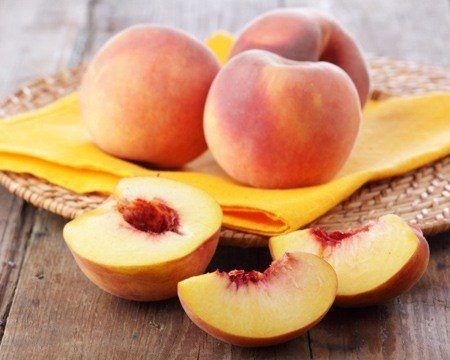Peachy Peach Recipes
With summer peaches at their peak, it's time to figure out just what to do with all that sweet, succulent fruit. There are so many possibilities to explore, and they're not just limited to dessert. From chutney to tatin and cobbler to salad, we've got you covered.
Click here to see the Peachy Peach Recipes Slideshow
But, before you start diving into that mountain of peaches and cooking up a storm, it may be helpful to consider a few things that will make your cooking experience easier and help make your dishes come out tastier.
First of all, it's worth considering what kind of peach to buy. There are more than 300 peach varieties, but unless you shop at a farmers market, you probably won't see most of them. All peach varieties, however, can be neatly divided into one of four easy-to-remember categories.
Freestone peaches are what most grocery stores will carry. Ripe freestone peaches can be easily "freed" of their pits, hence their name. The following method for separating the flesh from the pit works well on ripe freestone peaches: Use a paring knife to trace all the way around the fruit, making sure to touch the pit the whole way around. Then, gently grasp the two halves in each hand and twist. Voilà!
Clingstone peaches, on the other hand, are usually only found at farmers markets or used for processed products, such as canned peaches. This is not to imply, however, that they are inferior to freestone peaches. They are actually ideal for baking, since their delicate flesh is sweeter and juicier than their freestone counterparts, but it is their very delicateness that keeps them from being marketed commercially just for eating fresh.
Semi-freestone peaches are simply a mix of the two varieties.
Donut peaches are a relative newcomer to the store, but they are exactly what they sound like — a peach shaped like a donut. Donut peaches have reduced acid content and reach their peak in July and August.
Now that you've decided on what type of peach to buy, it pays to figure out how to make them last as long as possible. Peaches don't keep particularly well for long periods of time, so try to buy only as many as you plan on cooking or eating within the next day or two. It's awfully hard to resist buying a bunch at once, especially when confronted with a display of vibrant, fragrant peaches, but it's not worth the risk of having an entire batch of peaches go bad just because one goes moldy before all the others.
Peaches will vary greatly in hue, but a good rule of thumb is to always avoid any that have hints of green. These will not get sweeter as they ripen, only softer. And if it seems like your peaches need a little help ripening, try placing them in a paper bag for a day or two; placing them in a bag together with an apple or banana will help speed things along even more. But make sure to check frequently, since a peach ripens very quickly this way.
Lastly, if you need to peel a peach, to make a purée or a sauté, or perhaps even for baking (this depends on your preference): Blanch them quickly in a pot of boiling water and shock them in an ice bath, but do not allow them to sit in the bowl. Remove them as soon as they are cool enough to handle, and the skin should slip off easily. To keep them from oxidizing afterward, rub them with half a lemon.
There you have it. Now, to the kitchen!
Will Budiaman is the Recipe Editor at The Daily Meal. Follow him on Twitter @WillBudiaman.
